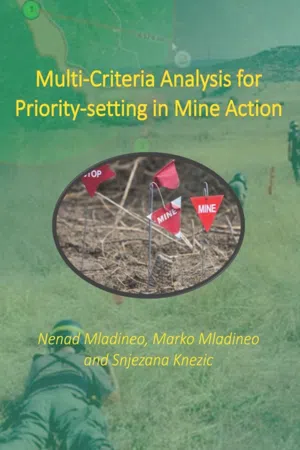
Multi-Criteria Analysis for Priority-setting in Mine Action
- 100 pages
- English
- PDF
- Available on iOS & Android
Multi-Criteria Analysis for Priority-setting in Mine Action
About this book
In 2016, three pyrotechnicians working on humanitarian demining in Croatia died in action in three separate incidents. These incidents occurred 21 year after the end of the war and armed conflicts in Croatia. In all three incidents casualties were caused by deadly anti-personnel Yugoslavian mines PROM-1, which were 'seeded' during the war in period 1991-1995. These incidents prove that the only thing bad as war itself are remains of war: mines and unexploded ammunition. It is not hard to conclude that mine contamination is one of the main obstacles to economic recovery and other types of progress in mine-affected countries. Therefore, the primary goal of humanitarian demining operations (mine actions) is to clear all suspected minefields and restore them so as to make them available for their previous use. The financial shortfalls result in the need for priority-setting in the mine action process. This book describes and investigates a new approach to priority setting within mine action, with the introduction of a Decision Support System (DSS) for mine action management. The proposed DSS is focused on determining the objective priorities required to reduce the risks stemming from mine contamination. DSS is based on a combination of Geographic Information System (GIS) analysis and a Multi-Criteria Analysis (MCA) in order to enable efficacious mine action management, namely setting humanitarian demining priorities in order to optimally reduce the risk caused by mines. Furthermore, priority-setting based on scientific Multi-Criteria Analysis (MCA), like the PROMETHEE method used in this research, can help overcome the differences in priorities between different stakeholders (local inhabitants, politicians, mine-action experts, donors, etc.). Scientific MCA procedure is a transparent process, thus creates confidence in the whole priority-setting procedure. The idea of having transparent process taking into account all relevant criteria and preferences of the stakeholders is the main idea of this research and it has been presented through three different Case Studies.
Frequently asked questions
- Essential is ideal for learners and professionals who enjoy exploring a wide range of subjects. Access the Essential Library with 800,000+ trusted titles and best-sellers across business, personal growth, and the humanities. Includes unlimited reading time and Standard Read Aloud voice.
- Complete: Perfect for advanced learners and researchers needing full, unrestricted access. Unlock 1.4M+ books across hundreds of subjects, including academic and specialized titles. The Complete Plan also includes advanced features like Premium Read Aloud and Research Assistant.
Please note we cannot support devices running on iOS 13 and Android 7 or earlier. Learn more about using the app.
Information
Table of contents
- Preface
- Acknowledgements
- Table of Contents
- 1 Introduction
- 2 Mine action management
- 3 Priority-setting in mine action
- 4 Building DSS for effective mine action management
- 5 Case Study: Pilot-project of DSS for “Sisacko-moslavacka County”
- 6 Case Study: GIS-based DSS for mine-affected water resources
- 7 Case Study: Web GIS-based MCA for priority selection (FP7-TIRAMISU tool)
- 8 Conclusion
- 9 References
- 10 Appendix: User manual for “GIS-based Multi-Criteria Analysis of priority selection in humanitarian demining” (FP7-TIRAMISU tool)
- 11 Authors Biographies